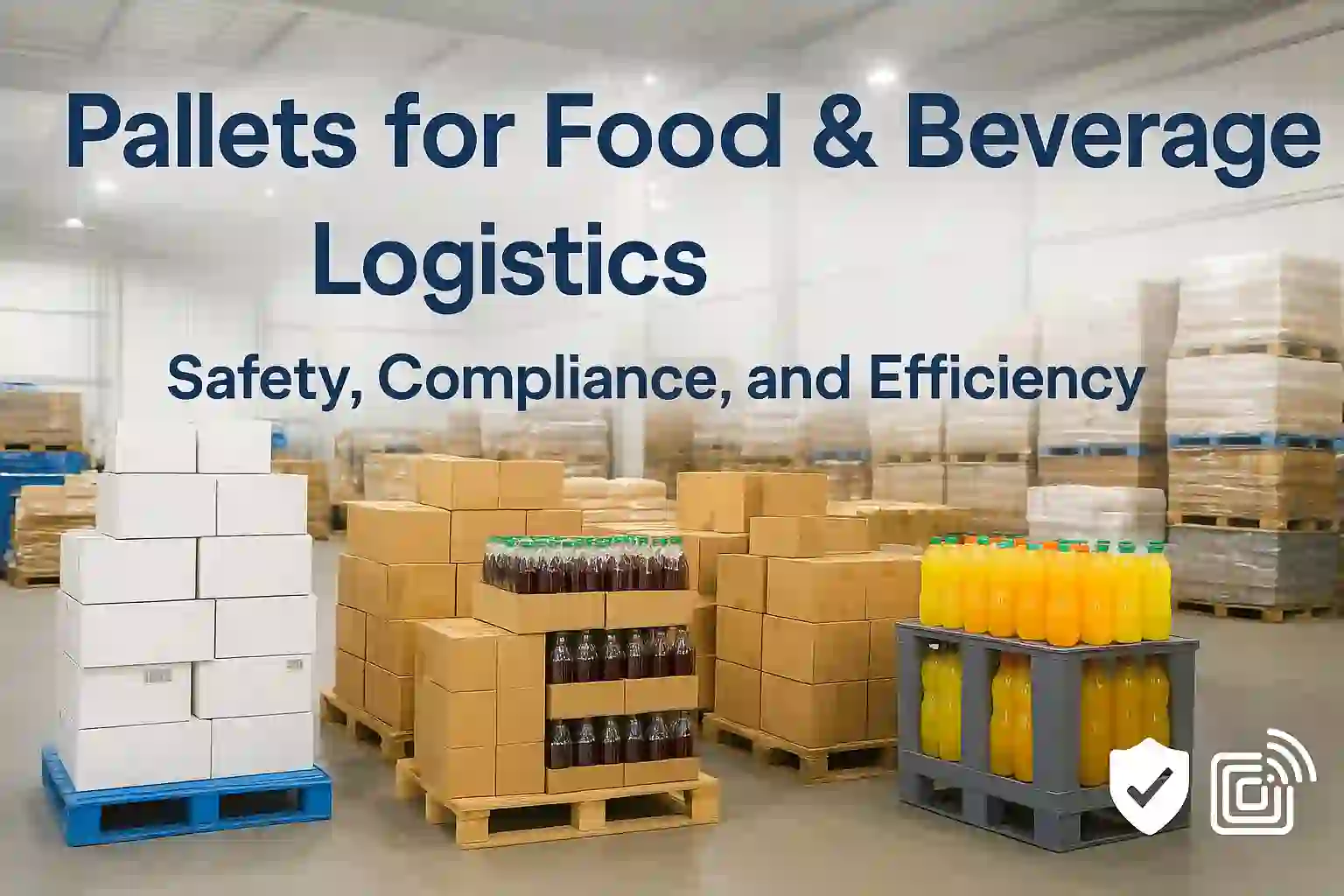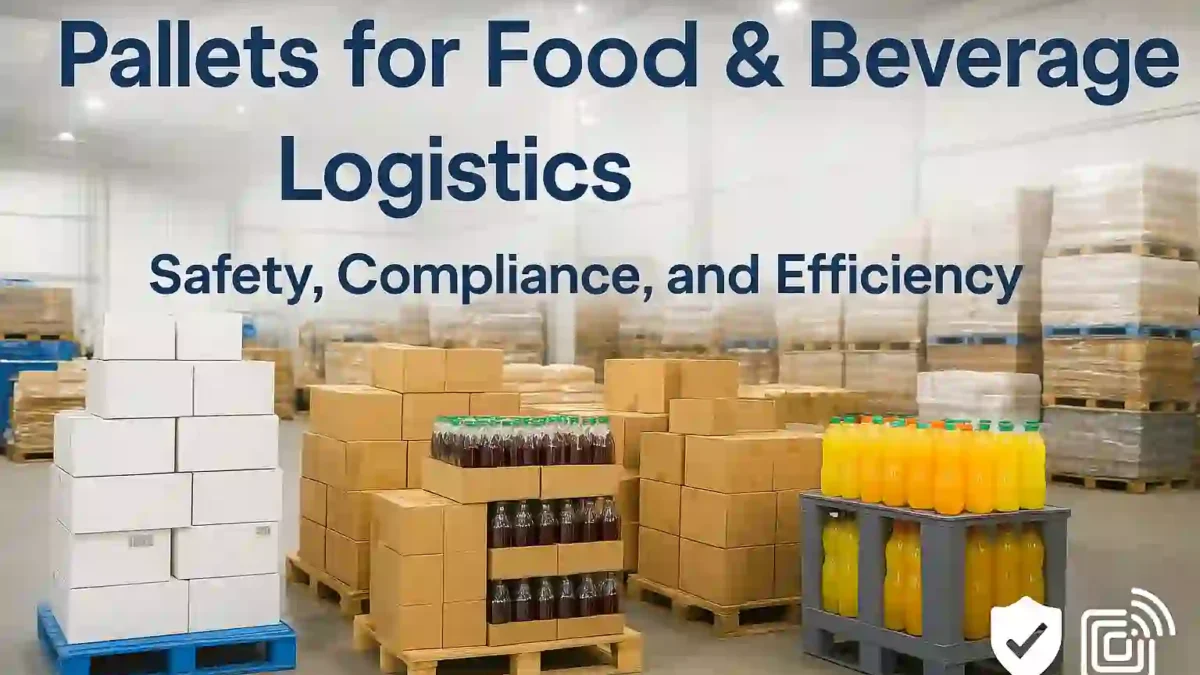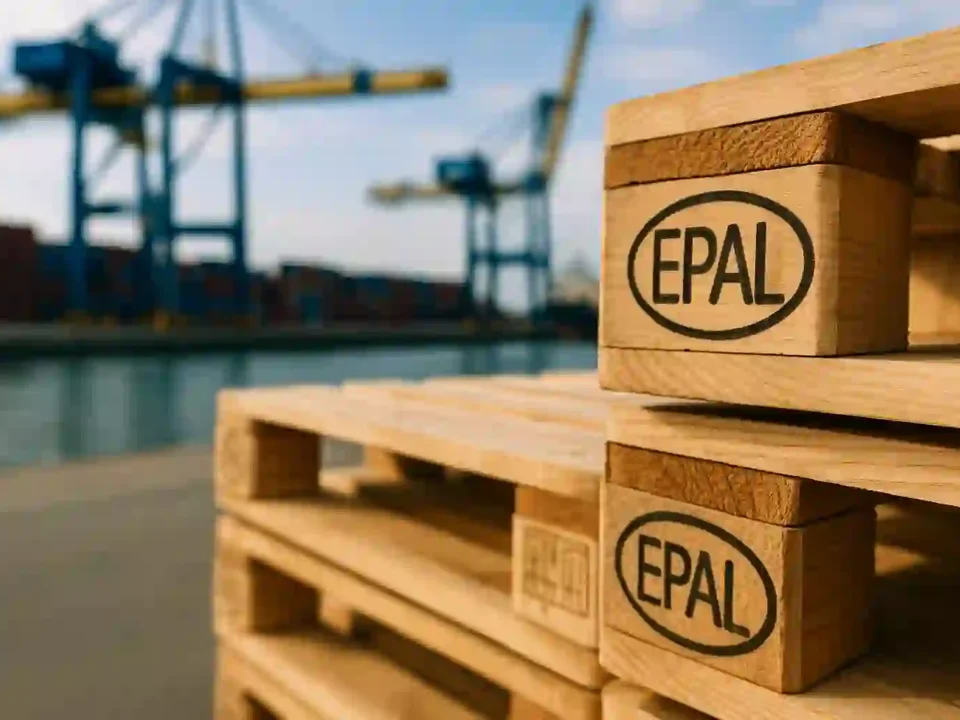
Chemical Industry Pallet Safety Standards
September 14, 2025
wooden pallets carbon footprint
October 21, 2025Pallets for Food and Beverage Logistics: Choosing the Right Type for Safety, Efficiency, and Compliance
In the food and beverage industry, pallets are more than just platforms; they’re a critical part of your logistics, hygiene, and compliance ecosystem. Choosing the wrong pallet can lead to product contamination, shipment damage, customs issues, and even regulatory fines. On the other hand, the right pallet boosts efficiency, reduces waste, and ensures audit readiness.

This guide covers everything you need to know: pallet types, emerging technologies, lifecycle costs, regulatory compliance, operational workflows, and best practices tailored to different F&B subsectors.
Role of Pallets in Food and Beverage Logistics
Pallets are the backbone of logistics operations. They support storage, transport, and handling of goods while directly influencing safety, efficiency, and cost. In food and beverage logistics, their role is even more critical due to stringent hygiene and safety requirements.
Key functions include:
- Transportation: Pallets provide stability, preventing products from shifting, toppling, or breaking during handling and transit.
- Storage: Pallets maximize warehouse space while protecting products from direct contact with floors, reducing contamination risk.
- Hygiene: Properly maintained pallets prevent microbial growth, chemical contamination, or pest infiltration.
- Operational Efficiency: Standardized pallets streamline automation, robotic handling, and conveyor systems.
Poor pallet selection or management can increase product loss, reduce throughput, and even cause failed audits in regulated environments.
Types of Pallets Used in the Industry
Choosing the right pallet material is critical. Here’s a breakdown of common options in F&B logistics:
Wooden Pallets
- Pros: Affordable, strong, widely available.
- Cons: Porous, susceptible to moisture and pests, may splinter.
- Compliance: Must meet ISPM-15 standards for international shipping (heat treatment and marking required).
- Best Use: Domestic shipping or non-food-contact storage zones.
Plastic Pallets
- Pros: Hygienic, non-porous, easy to sanitize, durable.
- Cons: Higher upfront cost.
- Best Use: Food-contact areas, cold storage, and closed-loop systems where hygiene is critical.
Metal/Composite Pallets
- Pros: Extremely durable, resistant to extreme temperatures, strong for heavy loads.
- Cons: Expensive, heavier to handle.
- Best Use: Cold chain, frozen goods, or specialized automation systems.
Smart and IoT-Enabled Pallets
- Equipped with RFID tags, sensors, and temperature monitoring.
- Allow real-time tracking and condition monitoring for high-value or temperature-sensitive goods.
| Pallet Type | Hygiene | Durability | Cost | Ideal Use Case |
|---|---|---|---|---|
| Wood | Moderate | High | Low | Domestic shipping, storage |
| Plastic | High | High | Medium-High | Food-contact areas, export |
| Metal | Very High | Very High | High | Cold chain, automation |
| Smart/IoT | Very High | High | High | Traceability, temperature monitoring |
Detailed or Region-Specific Standards and Regulations
Regulatory compliance is non-negotiable in F&B logistics. Understanding these standards helps avoid legal issues and ensures safe handling of food products.
Key Regulations
- ISPM-15 (International Standard for Phytosanitary Measures No. 15)
- Required for wood pallets used in international trade.
- Ensures wood is heat-treated to kill pests and stamped with the IPPC mark.
- EU Regulation 2021/127
- Implements EU plant health rules.
- Enforces ISPM-15 pallets compliance for wood entering EU markets.
- EU Food Hygiene Regulations (EC 852/2004)
- Covers hygiene requirements throughout the supply chain.
- Pallets must be clean, non-contaminating, and easy to sanitize.
- ISO 18613 pallet standards
- Standardizes the repair and maintenance of wooden pallets.
- Ensures structural integrity and safe reuse.
- BRCGS / IFS Standards
- Voluntary food safety certifications.
- Often require hygienic pallets and documented cleaning schedules.
Real Metrics: Measuring Pallet Efficiency
While many blogs discuss the pallet conceptually, few provide real-world data. Consider these practical metrics:
- Damage Reduction: Switching from untreated wood to plastic pallets can reduce product damage by up to 15–20% in beverage logistics.
- Cost Savings: Proper pallet selection and handling can cut overall transport and storage losses by 10–12%.
- Throughput Improvements: Standardized pallet sizes compatible with automation can increase warehouse picking and loading efficiency by 8–10%.
Metrics like these provide actionable insights for logistics managers and justify investment in better pallets.
Lifecycle Cost & Total Cost of Ownership
Upfront pallet cost is only part of the picture. Lifecycle costs include cleaning, repairs, replacement, and potential losses from product damage.
| Pallet Type | Purchase Cost | Maintenance | Lifespan | Notes |
|---|---|---|---|---|
| Wood | Low | Medium | 2–4 years | Repairable, risk of contamination |
| Plastic | Medium-High | Low | 5–8 years | Hygienic, reusable, easier compliance |
| Metal | High | Low | 10+ years | Heavy-duty, expensive upfront |
A holistic view of cost prevents short-term savings from turning into long-term losses.
Merging Technology and Materials
Modern logistics is adopting innovative pallet solutions:
- Smart Pallets: RFID and IoT sensors provide real-time tracking, impact monitoring, and temperature logging.
- Composite & Modular Designs: Lightweight, collapsible, and stackable pallets reduce storage costs and facilitate reverse logistics.
- Sustainable Practices: Pallet pooling and recycled materials reduce waste and support circular supply chains.
These innovations also help meet audit requirements while improving operational efficiency.
Challenges and Common Pitfalls
Even with the right pallet, operational mistakes can occur:
- Misuse: Overloading, improper stacking, or cross-docking errors.
- Cross-Contamination: Using pallets across food and non-food goods increases contamination risk.
- Cold Chain Effects: Moisture and freezing can compromise wooden pallets; condensation may lead to microbial growth.
- Damage Modes: Splintered boards, broken components, and structural failure are common failure modes.
Addressing these challenges requires process controls, inspection routines, and staff training.
Optimization for Different F&B Subsectors
Each product type has unique pallet requirements:
- Frozen Goods: Moisture-resistant, strong, and able to withstand freezing temperatures.
- Liquid/Bottled Products: Sturdy pallets with even load distribution and shock absorption.
- Dry Goods: Standard stackable pallets with good hygiene, minimal contamination risk.
- Fresh Produce: Lightweight, ventilated pallets that allow airflow and minimize spoilage.
Tailoring pallets to subsectors reduces losses and ensures compliance.
Operational Process Details
Efficient pallet management isn’t just about selection; it’s about workflow:
- Cleaning and Inspection: Scheduled sanitization, checking for damage, and replacing worn pallets.
- Receiving and Staging: Proper handling to prevent contamination and maintain organization.
- Reverse Logistics: Tracking returns, cleaning, and reusing pallets to maintain quality and reduce cost.
- Scheduling: Avoid overcrowding, improper stacking, and overloading to reduce the risk of damage.
Documented operational procedures ensure consistency and audit readiness.
Conclusion
Pallets may seem like a minor component in food and beverage logistics, but they play a central role in hygiene, compliance, efficiency, and cost management. Choosing the right pallet, whether wood, plastic, metal, or smart IoT-enabled, combined with proper inspection, cleaning, and workflow management, can save money, prevent losses, and ensure regulatory compliance.
The best pallet isn’t just strong. It’s compliant, hygienic, traceable, and optimized for the specific needs of your products and operations. Investing in the right pallet strategy today pays off in safety, efficiency, and peace of mind tomorrow.
Looking for compliant, hygienic, and cost-efficient pallet solutions for your food and beverage logistics? Contact our team to optimize your pallet operations and ensure compliance across your supply chain.




